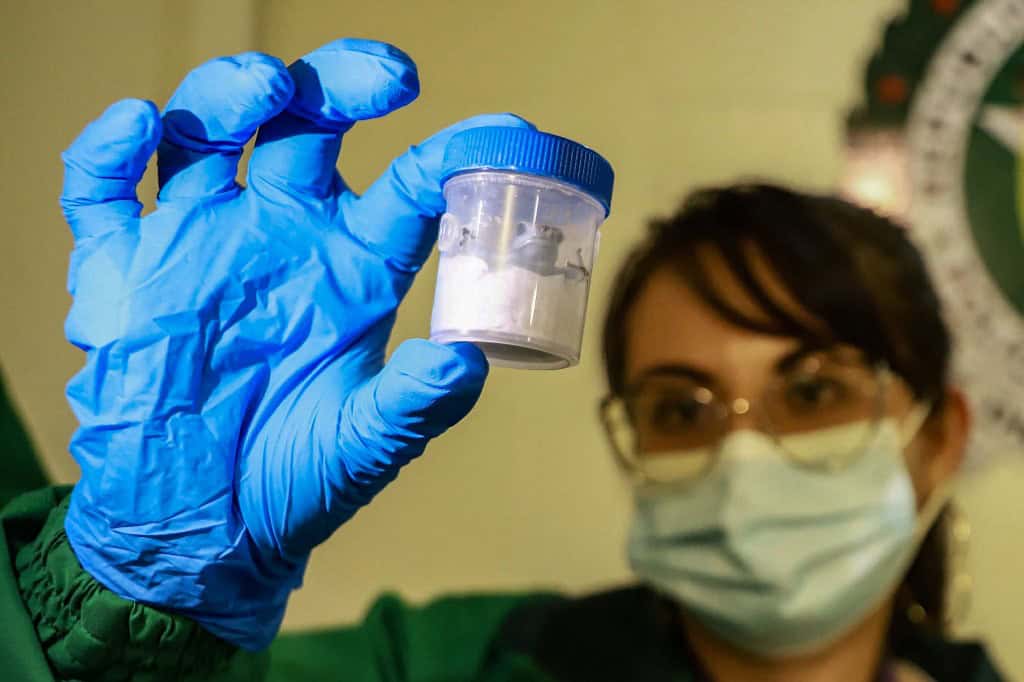Like a flash, a colorful harlequin frog jumps in its terrarium. In a laboratory in Colombia, dozens of these exotic amphibians await a buyer to take them as pets to another country, a “practical solution” against illegal trafficking. The “Oophaga histrionica” moves within its placid artificial habitat, green and humid in Tesoros de Colombia, a protected reservoir among the forests of Cundinamarca (center) accessed by a dirt road bordered by security cameras.
Illegal species trafficking networks lurk around this amphibian with a wide chromatic range, which does not reach half a centimeter in size and whose venom can cause respiratory paralysis. According to the International Union for Conservation of Nature, it is “critically endangered” in its natural environment, the Colombian Pacific.
“If there is an international demand for frogs, it is important to provide legal frogs that can also be reproduced in (their new) destination” abroad, said Ivan Lozano, founder of this center with a population of 14 species. Frog trafficking is punishable by between 5 and almost 12 years in prison in Colombia, host of COP16 in October and a biodiversity paradise.
But in the United States and European countries, possession of these amphibians is allowed and “millions of terrestrial vertebrate animals are taken alive from their environment in Colombia for international species trafficking,” he continues. Environmentalists estimate that 10% of the known amphibians in the world inhabit the Andean country, with 895 species.
For Lozano, the reservoir is a “practical” and legal solution for their conservation.
A better place
“They never cease to amaze me,” confesses Alejandra Curubo, a 35-year-old zootechnician, who proudly shows how another specimen “finished its metamorphosis” by detailing its “hands” and “feet” with a flashlight. Dozens of tadpoles stored in plastic containers swim eagerly, like this colorful “Oophaga histrionica fire”, or the poisonous “Oophaga lehmanni“, also critically endangered.
The self-sustaining project exports seven species to the international market and another seven are awaiting permits. “When we export them, we always go with the idea that they are going to a better place,” says the operational director of the center.
If they escape, frogs like these “could not adapt outside the controlled conditions of the terrarium and even inside a house,” confirms Curubo, unlike other animals that can alter the ecosystem. For example, the bullfrog, one of the 100 most aggressive invasive species, or the unwanted mongoose in Hawaii.
From Colombia, some frogs traveled more than 5,000 kilometers to Michael Heinrichs’ terrarium in Colorado, United States. He has a “small” collection of 40 specimens in a room he defines as his “zen place” and set apart, as the croaking “would drive his wife crazy.” “I can literally spend an hour watching the frogs, it’s a very calming and peaceful place,” says this 65-year-old enthusiast by phone, who has paid up to $1,000 for a specimen.
“I focus on high-quality frogs,” he maintains. He discovered Tesoros de Colombia in 2021 and bought an “Oophaga histrionica” from them, the “charismatic” and “dynamic” harlequin frog. “It’s a delight to have it,” he says. They leave the Colombian reservoir with a “fingerprint” to distinguish them from trafficked ones, sent to both authorities and buyers to avoid “frog swaps” or fraud, says Lozano, an expert in handling endangered species.
In their catalog, prices vary according to the regulation of the international market itself. The “Phyllobates terribilis”, known as the golden frog, has gone from $150 to about $40 currently, for example.
Noah’s Ark
Based on the United Nations Convention on Biological Diversity (CBD), signed by Bogotá in 1994, Tesoros de Colombia advocates for “legal biotrade,” Lozano defends. It coincides with initiatives from other countries such as butterfly farms in Costa Rica or endemic and threatened frog breeding centers in Ecuador.
It is the only institution in Colombia regulated since 2005 to commercialize these species, with a “very complex to obtain” license. In January, containers of photographic film rolls with 130 harlequin frogs were seized at El Dorado international airport.
But “the market for illegal trafficking from Colombia has dried up,” Heinrichs testifies. “It would be really difficult, very unlikely” to find these amphibians in the United States, the collector maintains. Lozano aspires to gradually release the frogs in captivity once the “international demand has decreased.”
The millionaire booty of illegal trafficking still overshadows it, being the fourth most profitable illicit business in the world, with annual revenues of $23 billion, according to the UN. “I hope we don’t have to be Noah’s Ark” in the face of their extinction, but if we do, “we’re ready,” he says with the croaking of his offspring in the background.






